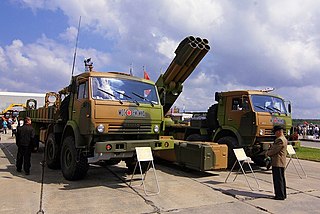 W
WThe 9A52-4 Tornado is Russia's newest universal multiple rocket launcher. It was designed as a lightweight and universal version of the BM-30 Smerch, dubbed 9A52-2. It was first unveiled in 2007 as a more strategically and tactically mobile launcher, albeit at the expense of a slight reduction in firepower. This model is aimed at replacing the previous generation of Russian multiple rocket launchers, including BM-21 Grad, BM-27 Uragan and BM-30 Smerch. Currently the sole operator is Russian Ground Forces. A version will be approved for export.
 W
WThe Bateleur is a South African self-propelled multiple rocket launcher. It is a 127mm system with a wheeled launcher vehicle, disposable pods, and fire control equipment developed by Denel Land Systems. Based on a mine protected Kwêvoël 100 10 ton 6x6 carrier. Its mission is to engage in counter-battery strikes against hostile artillery and air defences as far as 36 km (22 mi) away. Other potential warheads include cluster and an anti-tank mine dispenser. The weapon can fire up to 40 127mm pre-fragmented high explosive warheads to ranges of 7.5km to 36km at sea level singly or using ripple fire, firing up to 1 rocket per second. Reload can take less than 10 minutes and in/out-of-action time is one and two minutes respectively. The system is supported by a Kwêvoël 100 ammunition truck carrying 96 rockets and crew who help with the reloading.
 W
WThe K136 Kooryong is a South Korean rocket artillery system that was deployed in 1986. The multiple rocket launcher has 36 tubes and fires 130mm(K30, 기본형), 131mm(K33, 개량형) rockets. Payload is conventional High explosive and pre-fragmented HE, containing 16 000 steel balls at a range of 22 or 30 km. Launcher is carried on a KM809A1 6x6 truck. About 150 units were built.
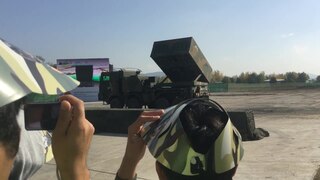 W
WThe K239 Chunmoo, also called the K-MLRS, is a South Korean rocket artillery system.
 W
WThe Kung Feng MLR series is a family of multiple rocket launcher systems used by the Republic of China (Taiwan).
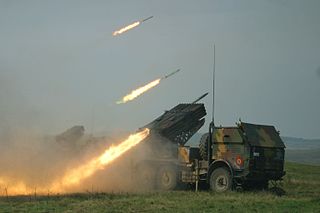 W
WThe LAROM is a Romanian native-made, highly mobile, multiple rocket launcher, attached to a DAC-25.360 6x6 truck, in service with the Romanian Land Forces, built in collaboration with Israel. Currently there are 54 systems in service, all operated by the 8th Mixed Artillery Brigade. Most likely it was influenced by the BM-21 Grad 122 mm multiple rocket launcher (MRL) system which entered service with the Soviet Army in 1963 also utilizing a six-by-six truck chassis fitted with a bank of 40 122mm launch tubes arranged in a rectangular shape that can be turned away from the unprotected cabin.
 W
WThe LRSVM Morava is a modular, multi-calibre, multi-pod self-propelled multiple rocket launcher designed and developed by the Serbian Military Technical Institute in Belgrade (VTI). The system is designed to offer subsystem modularity, enabling integration with wheeled or tracked platforms to fire unguided rockets of various calibres to engage targets at ranges between 8 km and 40 km.
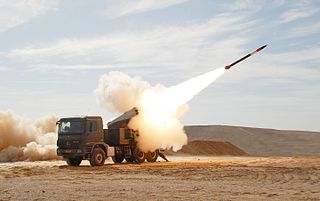 W
WLYNX is a multiple rocket launcher developed and manufactured by Israel Military Industries (IMI) and used by Israel Defense Forces and other countries.
 W
WA multiple rocket launcher (MRL) or multiple launch rocket system (MLRS) is a type of rocket artillery system that contains multiple launchers which assembled onto a same platform, and shoots its rocket ordnance in a fashion similar to a volley gun. Rockets are self-propelled in flight and have different capabilities than conventional artillery shells, such as longer effective range, lower recoil, typically considerably higher payload than a similarly sized gun artillery platform, or even carrying multiple warheads.
 W
WNDL-40 is a towed multiple rocket launcher developed and produced by IPTN of Indonesia. The weapon system used 70mm rockets as projectile. The rocket used is produced by IPTN under license from Belgium.
 W
WThe Nebelwerfer was a World War II German series of weapons. They were initially developed by and assigned to the Wehrmacht's "smoke troops" (Nebeltruppen). This weapon was given its name as a disinformation strategy designed to fool observers from the League of Nations, who were observing any possible infraction of the Treaty of Versailles, into thinking that it was merely a device for creating a smoke screen. They were primarily intended to deliver poison gas and smoke shells, although a high-explosive shell was developed for the Nebelwerfer from the beginning. Initially, two different mortars were fielded before they were replaced by a variety of rocket launchers ranging in size from 15 to 32 centimetres. The thin walls of the rockets had the great advantage of allowing much larger quantities of gases, fluids or high explosives to be delivered than artillery or even mortar shells of the same weight. With the exception of the Balkans Campaign, Nebelwerfer were used in every campaign of the German Army during World War II. A version of the 21 cm calibre system was adapted for air-to-air use against Allied bombers.
 W
WThe LRSVM M18 Oganj is a modular self-propelled multiple rocket launcher developed in Serbia on 6x6 chassis. It can have 2 to 8 containers with different guided and unguided missiles.
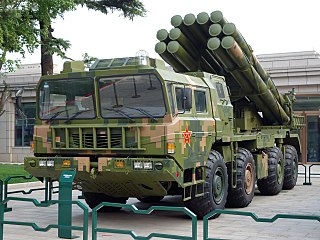 W
WThe PHL-03 is a truck-mounted self-propelled 12-tube 300 mm long-range multiple rocket launcher of the People's Republic of China.
 W
WThe PHL-81 is a truck-mounted self-propelled 122 mm multiple rocket launcher (SPMRL) produced by the People's Republic of China for the People's Liberation Army Ground Force.
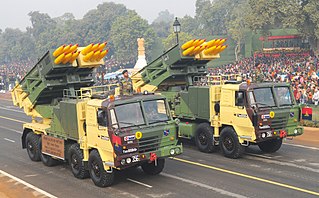 W
WPinaka is a multiple rocket launcher produced in India and developed by the Defence Research and Development Organisation (DRDO) for the Indian Army. The system has a maximum range of 40 km for Mark-I and 60 km for Mark-I enhanced version, and can fire a salvo of 12 HE rockets in 44 seconds. The system is mounted on a Tatra truck for mobility. Pinaka saw service during the Kargil War, where it was successful in neutralising enemy positions on the mountain tops. It has since been inducted into the Indian Army in large numbers.
 W
WThe Polonez is a Belarusian 300 mm rocket artillery system of a launcher unit comprising 8 rockets packaged in two four-rocket pods mounted on a MZKT-7930 vehicle. In 2018, it was exported to Azerbaijan. The system was designed by the Belarusian Plant of Precision Electromechanics in cooperation with a foreign country, probably China. The first combat missile launches were carried out in China. The 77th Separate Rocket Artillery Battalion of the 336th Rocket Artillery Brigade of the Belarusian Ground Forces is equipped with it. An upgraded version called Polonez-M passed all trials and has been accepted into service by the Belarusian Ground Forces as of May 2019. Polonez-M has an increased range of 290 km, a higher share of domestic components and can fire the improved A-300 missile.
 W
WR-Han 122 is a family of rocket artillery developed by PT Dirgantara Indonesia of Indonesia with maximum speed Mach 2.95 and maximum range of 32 km. It used primarily by the Indonesian military.
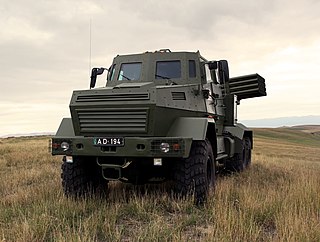 W
WThe RS-122 is a Georgian mobile multiple rocket launcher firing 122 mm rockets. It was developed in 2011 and put on production display in February 2012. The RS-122 is a heavily modified version of the Soviet BM-21 Grad. Its main characteristics are the armoured crew cabin, improved firing, operational range and accuracy. The vehicle was developed by the state-owned Scientific Technical Centre Delta.
 W
WThe T-122 Sakarya is a Turkish multiple launch rocket system developed by ROKETSAN.
 W
WThe Thunderbolt-2000 is a wheeled MLRS system used by the Republic of China (Taiwan) Army. It was created with the intention of attacking enemy forces when disembarking from sea.
 W
WTOS-1 is a Soviet 220 mm 30-barrel or 24-barrel multiple rocket launcher and thermobaric weapon mounted on a T-72 tank chassis. TOS-1 was designed to attack enemy fortified positions, open country and in lightly armoured vehicles and transport. First combat tests took place in 1988–1989 in the Panjshir Valley during the Soviet–Afghan War. The TOS-1 was shown for the first time in public in 1999 in Omsk.
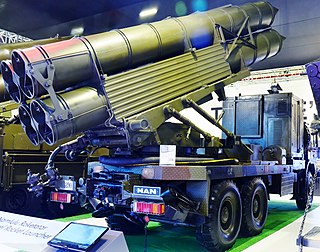 W
WThe TRG-300 Tiger is a Turkish multiple launch rocket system manufactured by the ROKETSAN corporation. The system has four 300 mm rocket launcher tubes and its rockets can hit a maximum range of 120 km.
 W
WThe Type 63 multiple rocket launcher is a towed, 12-tube, 107mm rocket launcher produced by the People's Republic of China in the early 1960s and later exported and manufactured globally. Although no longer serving with active infantry units, the Type 63 is still in People's Liberation Army service with specialized formations such as mountain infantry units and special forces detachments. The Type 63 was widely used in the PLA until the late 1980s. It was adopted as the successor of the Type 50-5 of 102mm.
 W
WThe Valkiri is a South African self-propelled multiple rocket launcher. It is a 127mm system with a wheeled launcher vehicle, disposable pods, and fire control equipment developed by Denel Land Systems. Contemporary models consist of a single launch module with five eight-cell rocket pods on a Unimog or SAMIL-100 carrier. Its mission is to engage in counter-battery strikes against hostile artillery and air defences as far as 36 km (22 mi) away. Other potential warheads include cluster and an anti-tank mine dispenser.
 W
WThe Weishi family of multiple rocket launcher systems were mainly developed by Sichuan Aerospace Industry Corporation in Chengdu, China. The systems include the 302 mm (11.9 in) WS-1, the improved 302 mm (11.9 in) WS-1B, the 122 mm (4.8 in) WS-1E, the 400 mm (16 in) WS-2, as well as many other models. The WS-1 series weapon system did not enter PLA service and has order from Thailand. The WS-2 may finally see PLA service in the future. It's worth noticing that although sharing the same name, there are other developers for different models of Weishi series multiple rocket launchers (MRL) other than the primary developer SCAIC.
 W
WThe WM-80 was a multiple rocket launcher used by the People's Liberation Army of China and sold to other states like Armenia.
 W
WWR-40 Langusta is a Polish self-propelled multiple rocket launcher developed by Centrum Produkcji Wojskowej HSW SA. The first 32 units of the WR-40 entered service in 2010.
 W
WThe Wurfrahmen 40 was a German World War II multiple rocket launcher. It combined a vehicle such as the Sd.Kfz. 251 halftrack or captured French Renault UE Chenillette with rocket artillery to form a more mobile and protected artillery piece than the towed Nebelwerfer. It was nicknamed Stuka zu Fuss and Heulende Kuh.